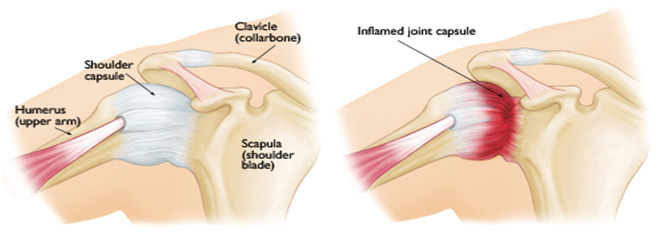
Frozen Shoulder
A stiff shoulder with less than 50% of normal range of active and passive motion in any direction. Frozen Shoulder is a freezing of the joint where all the movements get restricted. Frozen Shoulder Syndrome (FSS) is a common and debilitating condition. you cant lift the shoulder and neither can anyone else lift it for you it is completely stiff and locked.

Frozen Shoulder
Inflammation of the joint,
Stiffness of the joint
Decrease range of motion
Risk Factors for Frozen Shoulder
which increase the risk of frozen shoulder.
Ageing - In Japan frozen shoulder syndrome is called "Fifties
Shoulder".seems to effect 40 to 70 yrs olds.
Posture - especially round-shouldered
Shoulder-intensive sports
Shoulder intensive or repetitive manual occupation
Diabetes - Types I and II-five times more common in diabetic patients
Trauma
Immobilization / splinting
Fracture of the collar bone or humerus (arm bone)
Can occur after Surgery (especially after shoulder surgery, or mastectomy with breast reconstruction)
More common in women (60%)
Slightly more common in patients with Dupytren's contracture
About 15% of people develop frozen shoulder on both sides (commonly within 6-12 months of the first occurrence)
In the case of female patients, Frozen Shoulder occurs more commonly at about the same time as the menopause.
Pain Management-
Give NSAID(non-steroidal anti-inflammatory drugs)- These medications target the enzymes that produce prostaglandins, blocking their production and ultimately decreasing your pain
We have to avoid spicy and sour food every day which aggravate the inflammation.
Home programme
Hot and Cold therapy is a simple and effective therapy that you can do on your own by alternating between hot and cold packs on the painful area. The heat helps to soften the muscles in the area and reduce pain. The alternating of the 2 temperatures causes your blood vessels in the area to widen with heat and constrict with cold.
Physiotherapy
According to the stage of the frozen shoulder physiotherapy sessions are required. its takes 15 days time,20 days of time or in severe case 2 month time is required for treatment.
Aim of physiotherapy treatment
To reduce pain
To increase extensibility of the thickened and contracted capsule of the joint.
To improve mobility of the shoulder joint.
To improve strength of the muscles.
Treatment
Reduce pain through advance modalities.
Give Mobilization to the patient to increase joint range of motion (manual therapy)
stretching of muscles
Reduce tightness
Reduce spasm of the muscle
postural guidance and re-education
Home Programme

